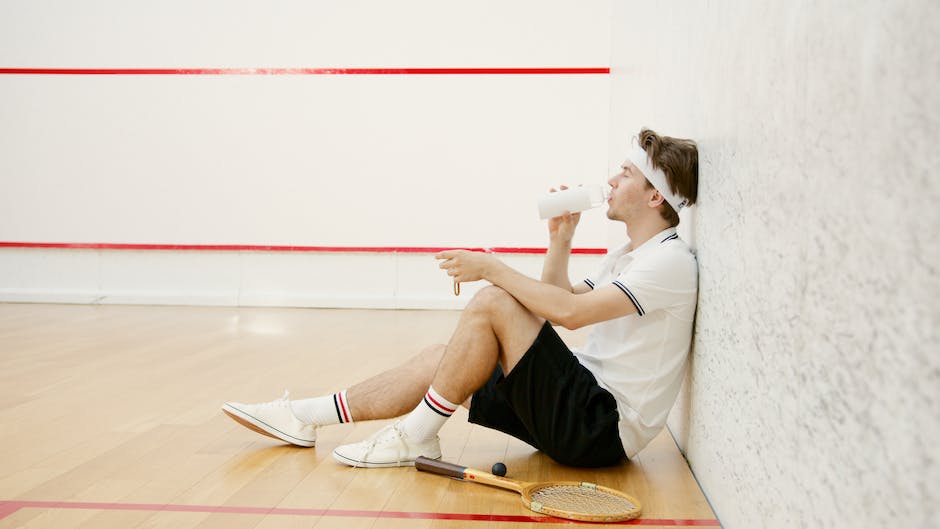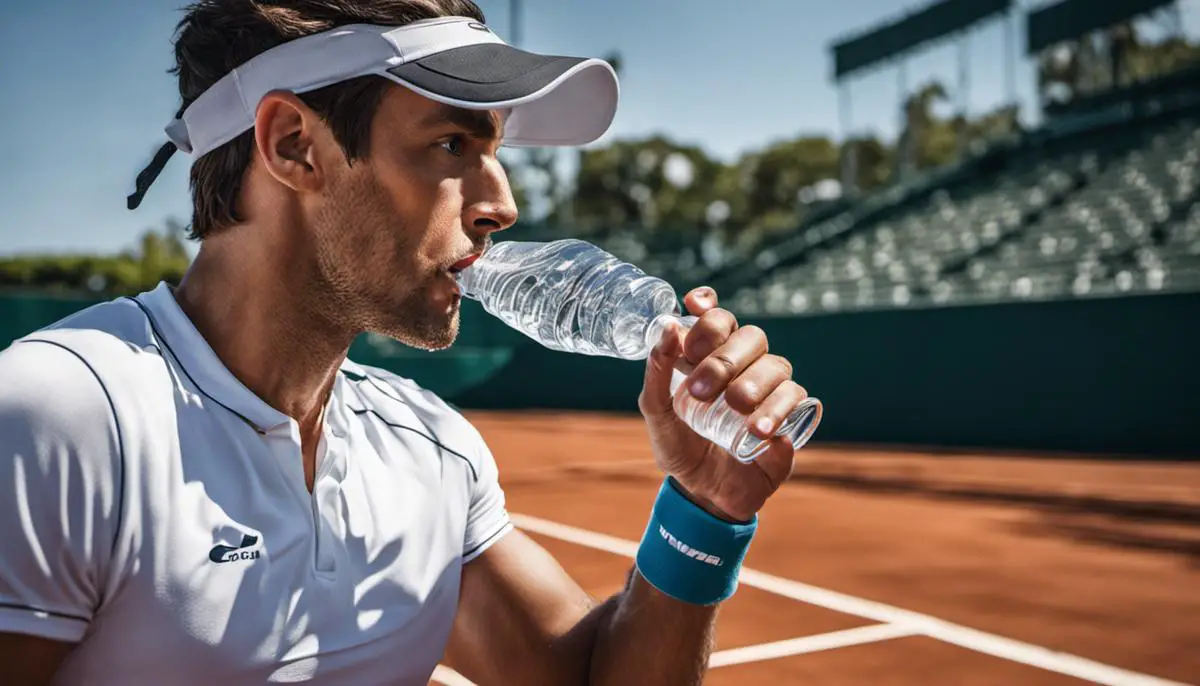Whether you’re an enthusiastic amateur or a seasoned professional, tennis is a demanding sport that tests both your physical endurance and mental alertness. A crucial but often overlooked aspect of tennis performance is adequate hydration. As a high-intensity sport typically played in warm, sunny weather, tennis can cause players to lose significant amounts of fluid through sweat. This loss, if not adequately replenished, can lead to dehydration, significantly affecting performance and even health. The importance of understanding and implementing effective hydration strategies cannot be underestimated, making it critical to athletes aiming for peak performance.
Understanding the Importance of Hydration in Tennis
The Crucial Role of Hydration in Tennis
Proper hydration is crucial to any athlete’s performance, especially in a high-intensity sport like tennis. During an intense tennis match, players can lose up to 2-3 liters of sweat per hour. This rapid fluid loss can negatively affect the physiological functions of the body, including muscle contraction, blood circulation, and thermoregulation. Therefore, maintaining proper hydration can significantly enhance performance, delay fatigue, and reduce recovery time.
Effects of Dehydration on Athletic Performance
Dehydration can have severe consequences on a tennis player’s performance. Even mild dehydration, when the body loses just 1% of its total water, can impair physical performance and cognitive skills. As dehydration progresses, the detrimental effects become more dramatic, leading to decreased endurance and speed, muscle cramps, heat exhaustion, and in severe cases, heatstroke. Dehydration can also impair the body’s ability to regulate its temperature, putting players at risk in hot tournament conditions.
Mental Components of Dehydration
The effects of dehydration extend beyond the physical sphere, impacting cognitive and psychological functioning. A dehydrated player may experience reduced concentration, slower reaction times, and increased perceived exertion. Such deficits can impair decision-making abilities, a crucial component of a strategic sport like tennis.
Recognizing Signs of Dehydration
Understanding the signs of dehydration is as crucial as maintaining proper hydration. Thirst isn’t always an accurate indicator since it only begins when the body is already dehydrated. Other signs to look out for include dry mouth, fatigue, headache, dizziness, decreased urine output, or urine that is a darker yellow.
Hydration Strategies for Tennis Players
To prevent dehydration, tennis players should aim to start each match fully hydrated. This involves consuming a suitable amount of fluids in the 24 hours leading up to a match, with an emphasis on the 2-3 hours prior to the game. Intake during the match is also crucial, with recommended intakes varying depending on individual sweat rates. To encourage hydration, cold beverages with added flavors can be consumed, as research shows that athletes tend to drink more when fluids are flavored and chilled. An appropriate hydration plan also includes post-match replenishment to replace lost fluids and accelerate recovery.
Importance of Electrolytes
Hydration isn’t just about water – it also involves replenishing vital electrolytes lost through sweat, like sodium and potassium. These substances play a crucial role in maintaining the body’s fluid balance and muscle function. Drinks containing electrolytes can help decrease urine output, stimulate thirst, and improve fluid retention, making them an essential part of an athlete’s hydration strategy.
By understanding the importance and impact of hydration, tennis players can improve their on-court performance, ensuring they can handle intense matches in climatic conditions while minimizing related health risks.

Identifying Hydration Needs for Tennis Players
Determining Intensity of Play
One factor that influences a tennis player’s hydration needs is the intensity of play. This includes both the duration and the physical demand of the game. Longer and more intense matches or practices can cause players to lose more fluid through sweat and require higher hydration levels. Beginners who play less intensely may need to drink about two cups of water or sports drink an hour, while advanced players might need up to four cups.
Considering Weather Conditions
Weather conditions greatly impact a tennis player’s hydration needs. Warmer temperatures and higher humidity can increase the rate of perspiration, thus requiring higher fluid intake. If playing under extreme heat, tennis players might need to consume up to 16 ounces of water, not just before starting, but also during breaks and after the match. In comparison, playing under colder or less humid conditions might require less hydration.
Accounting for Player’s Size
A player’s size directly impacts hydration needs. Simply put, larger individuals tend to sweat more than smaller ones. Thus, players with larger body sizes generally need to consume more fluids than those with smaller body sizes. Moreover, body composition also comes into play because muscle tissues tend to generate more heat than fat, leading to increased sweating and hydration needs.
Understanding Individual Sweat Rate
Everyone sweats at different rates and sweat rate is a crucial factor in understanding a player’s hydration needs. It’s important to calculate your sweat rate by weighing yourself before and after an hour of tennis. The weight lost is mostly water weight to be replaced. For every pound lost, drink approximately 16 ounces of water or a sports drink. Other signs of excessive dehydration to watch for are dark urine, fatigue, or muscle cramps.
Monitoring Hydration Levels
Understanding thirst as an indicator of dehydration is paramount. Thirst is a late sign of dehydration, which should be avoided by frequent sipping of water or sports drinks. Light yellow urine is a good sign of proper hydration. This should be monitored regularly. Making a hydration plan that includes drinking fluids before, during, and after playing can help to manage hydration levels effectively.
By considering these factors, tennis players can effectively determine their unique hydration needs to improve performance and prevent dehydration-related issues.

Implementing Effective Hydration Strategies for Tennis Players
Understanding the Importance of Hydration
Hydration is crucial for tennis players as they lose a significant amount of water through sweating while playing. Moreover, tennis is often played in the heat, which can lead to further water loss. Dehydration could lead to a decline in performance, with poor concentration, reduced strength, and slower reaction times.
Hydration Before a Match
It is vital for tennis players to start hydrating hours before their match to ensure optimal physical performance. Ideally, tennis players should aim to consume about 16-20 ounces of water four hours ahead of a match. If urine color is darker than light yellow, players should consume an additional 8-10 ounces of fluid two hours before the match. Also, it’s beneficial to consume drinks that contain electrolytes to maintain an optimal water-salt balance in the body.
Hydration During a Match
During a tennis match, players can typically lose between 1-2 litres of sweat per hour, depending on the intensity of the match and the environmental conditions. To compensate for this fluid loss, tennis players should aim to consume about 7-10 ounces of fluid every 10-20 minutes. Isotonic sports drinks can be considered as they are quickly absorbed into the body and provide both carbohydrate (energy) and electrolytes which are lost in sweat.
Identifying Signs of Dehydration
It’s crucial to identify signs of dehydration early to prevent it from affecting performance. Common signs include headache, dizziness, dark urine, dry mouth, fatigue, and rapid breathing. If any of these symptoms begin to present, immediate action should be taken to increase fluid intake.
Hydration After a Match
Post-match hydration is equally important to a player’s recovery and performance in subsequent matches. Players must replace the fluid they have lost during the match, ideally consuming 16-24 ounces of fluid for every pound of body weight lost. Recovery drinks should contain sodium to replace lost salts and carbohydrates to refuel muscles. Additionally, consuming a water-rich snack, such as a piece of fruit, can further aid in replenishing lost fluid levels.
Appropriate Choice of Drinks
The choice of an appropriate drink is pivotal to a player’s hydration strategy. Water is an excellent choice for short matches or practice sessions, whereas isotonic sports drinks are ideal for longer matches due to their ability to provide energy and replace electrolytes. Avoid drinks with high levels of sugar or caffeine as they can lead to quick energy crashes and can promote dehydration.
Hydration is an individual process
What works for one player may not work for another. Therefore, tennis players should aim to develop a personalized hydration strategy that best suits their body, play style, and environmental conditions.

Having explored the importance of hydration in tennis, understanding individual hydration needs, and implementing effective strategies, it’s clear that proper hydration is essential for every player’s best performance. From selecting appropriate beverages to spotting dehydration signs and utilizing recovery hydration techniques, adopting an effective hydration strategy can make a significant difference. Remember, your body’s requirement may differ based on various factors, so always listen to its signals. Armed with this knowledge, tennis players can now embark on their journey to maximizing their performance and maintaining their health on and off the court.
